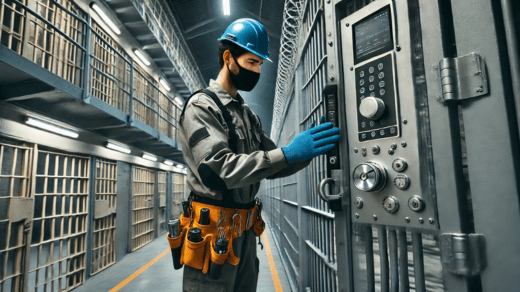Walking into a detention facility, most people only see locked doors and barred windows. What they don’t notice is the highly engineered security infrastructure designed to prevent breaches, protect staff, and ensure the safety of those inside. Behind every reinforced door, surveillance system, and custom locking mechanism, detention equipment contractors play a vital role in making these facilities nearly impenetrable.
What Makes Security Barriers in Detention Facilities Nearly Indestructible
Walls and barriers in detention centers aren’t just concrete and steel; they are meticulously designed to withstand extreme pressure, force, and even tampering attempts. Unlike standard commercial or residential walls, these security barriers contain reinforced concrete with additional steel mesh or embedded security panels to prevent cutting, drilling, or forced removal. This level of construction ensures that no weak points exist, reducing the risk of breaches.
Detention equipment contractors engineer these barriers to resist more than just physical force. Fire-resistant coatings, impact-resistant materials, and anti-ram reinforcements help withstand potential threats like riots or escape attempts. Even ventilation systems and utility access points are designed to eliminate vulnerabilities. These features ensure that every inch of the facility contributes to overall security rather than creating an opportunity for unauthorized movement.
The Role of High-Tensile Steel in Preventing Forced Entry and Escape
Steel plays a significant role in detention security, but not just any steel. High-tensile steel is specifically used in doors, frames, barriers, and fencing to prevent cutting, bending, or breaking under stress. This type of steel is much stronger than standard structural steel and can endure repeated force without deformation. It is often layered with additional security coatings that prevent rust and wear, ensuring long-term durability.
Security detention equipment contractors strategically place high-tensile steel throughout a facility. From reinforced gates to tamper-resistant bunk frames, every component must withstand sustained impact. Even floor and ceiling reinforcements include steel plates that deter escape attempts from above or below. The extensive use of high-strength materials ensures that unauthorized access remains nearly impossible.
How Custom Locking Systems Control Access Without Weak Points
Locks in a detention facility aren’t the same as the ones found in homes or office buildings. These custom locking systems are built with advanced technology and mechanical reinforcements that eliminate weak points. Unlike traditional key-and-bolt mechanisms, detention locks are often controlled electronically, allowing for remote access control and immediate lockdown when needed.
Security detention equipment contractors design these systems to resist picking, tampering, or forced entry. Some facilities integrate biometric access controls, while others use reinforced deadbolts that can withstand extreme pressure. Even if an individual gains access to one area, additional layers of locks ensure they cannot move freely. Every locking point in a detention facility is built to withstand aggressive attempts at manipulation.
Why Reinforced Glass and Tamper-Proof Windows Are Critical for Safety
Windows in detention centers must strike a balance between visibility and security. Standard glass would be a liability, shattering easily under pressure. Instead, reinforced glass made of laminated polycarbonate layers provides the necessary strength to prevent break-ins, breakouts, or even contraband smuggling. These windows are designed to be impact-resistant, making it nearly impossible to shatter them without specialized tools.
Tamper-proof window frames further secure these openings. Unlike standard residential or commercial windows, these frames are embedded deep into reinforced walls, preventing anyone from prying them open or removing them. Security detention equipment contractors install these systems with precision, ensuring no gaps or weak points exist that could be exploited. Even small observation windows in doors are built to resist physical force while maintaining clear visibility for staff.
Secure Door Frames and Hinges In Preventing Manipulation and Breaches
A secure door isn’t just about the lock—it’s also about the frame and hinges. Many assume that a thick steel door is enough to prevent a breach, but without a reinforced frame, it can still be forced open. That’s why detention equipment contractors use heavy-gauge steel frames, which are anchored deep into the walls with high-security fasteners that cannot be removed from the outside.
Hinges are another potential weak point in standard doors. In detention settings, security-grade hinges are welded, reinforced, or concealed to prevent tampering. Some facilities even use continuous hinges that run the full height of the door, eliminating any space for tools to be inserted. These reinforced doors and hardware ensure that no amount of prying or brute force can compromise security.
The Hidden Engineering That Keeps Surveillance Systems Fully Protected
Surveillance cameras play a critical role in detention facility security, but installing them isn’t as simple as mounting them on a wall. These systems must be protected from tampering, vandalism, and even cyber threats. Security detention equipment contractors ensure cameras are installed in reinforced housings that prevent damage, while also securing wiring to prevent anyone from disabling them.
Beyond physical security, surveillance systems require encrypted connections and redundant power supplies to function under all conditions. In high-risk areas, cameras are equipped with impact-resistant domes, ensuring they remain operational even during disturbances. By integrating surveillance into the overall security framework, contractors help facilities maintain constant visibility without vulnerabilities.

